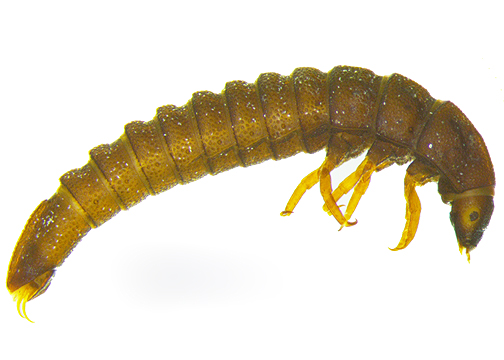Abstract
A single elmid larva is reported from a laminate maroon shale bed of Gurha opencast lignite mine (Palana Formation, early Eocene, Bikaner District, north-western Rajasthan, India). It is the first fossil larva that can be attributed to Elmidae with certainty. A generic assignation is not possible, because the larva is strongly compressed, and the most important characters are not visible or poorly preserved. The larva is described morphologically and illustrated by photographs and line drawings. A larva of a holometabolous insect from Baltic amber, which was published recently as a member of Elmidae by Zippel et al. (2022), possesses no structural characters that would clearly suggest placement in this family. A photograph of the hitherto unknown larva of the extant Grouvellinus rioloides from Kyrgyzstan is included for comparison.
References
- Ashworth, A.C. & Nelson, R.E. (2014) The paleoenvironment of the Olympia beds based on fossil beetles from Discovery Park, Seattle, Washington, U.S.A. Quaternary International, 341, 243–254. https://doi.org/10.1016/j.quaint.2013.09.022
- Bertrand, H. (1972) Larves et nymphes des Coléoptères aquatiques du globe. F. Paillart, Paris, 804 pp.
- Bukejs, A., Alekseev, V.I. & Jäch, M.A. (2015) The riffle beetles (Coleoptera: Elmidae) of the Eocene Baltic amber: Heterelmis groehni sp. nov. and Heterlimnius samlandicus (Bollow, 1940) comb. nov. Zootaxa, 3986 (4), 452–460. https://doi.org/10.11646/zootaxa.3986.4.4
- Green, C.P., Branch, N.P., Coope, G.R., Field, M.H., Keen, D.H., Wells, J.M., Schwenninger, J.-L., Preece, R.C., Schreve, D.C., Canti, M.G. & Gleed-Owen, C.P. (2006) Marine isotope stage 9 environments of fluvial deposits at Hackney, north London, UK. Quaternary Science Reviews, 25, 89–113. https://doi.org/10.1016/j.quascirev.2004.10.011
- Haupt, H. (1956) Beitrag zur Kenntnis der eozänen Arthropoden-fauna des Geiseltales. Nova Acta Leopoldina, (N.F.), 18, 1–90.
- Hayashi, M. & Okushima, Y. (2012) A fossil record of Elminae (Coleoptera, Elmidae) from the Upper Miocene in Tastumi-tôge [= Tatsumi-tôge], Tottori Prefecture, western Honshu, Japan. Bulletin of the Kurashiki Museum of natural History, 27, 5–7. [In Japanese, with English title and abstract]
- Hayashi, M., Yahiro, K. & Kitabayashi, E. (2008) Middle Pleistocene fossil insects from the Yoshino Formation of Kawachi-machi, Kumamoto City, Kyushu, Japan. Bulletin of the Mizunami Fossil Museum, 34, 95–98. [In Japanese, with English title and abstract]
- Jäch, M.A., Kodada, J., Brojer, M., Shepard, W.D. & Čiampor, F. (2016) Coleoptera: Elmidae and Protelmidae. World Catalogue of Insects, 14. Leiden, Brill, XXI + 318 pp. https://doi.org/10.1163/9789004291775
- Keen, D.H., Coope, G.R., Jones, R.L., Field, M.H., Griffiths, H.I., Lewis, S.G. & Bowen, D.Q. (1997) Middle Pleistocene deposits at Frog Hall Pit, Stretton-on-Dunsmore, Warwickshire, English Midlands, and their implications for the age of the type Wolstonian. Journal of Quaternary Science, 12, 183–208. https://doi.org/10.1002/(SICI)1099-1417(199705/06)12:3<183::AID-JQS298>3.0.CO;2-Q
- Kumar, M., Monga, P., Shukla, A. & Mehrotra, R.C. (2017) Botryococcus from the early Eocene lignite mines of western India: inferences on morphology, taphonomy and palaeoenvironment. Palynology, 41, 462–471. https://doi.org/10.1080/01916122.2016.1259667
- Kumar, M., Spicer, R.A., Spicer, T.E.V., Shukla, A., Mehrotra, R.C. & Monga, P. (2016) Palynostratigraphy and palynofacies of the early Eocene Gurha lignite mine, Rajasthan, India. Palaeogeography, Palaeoclimatology, Palaeoecology, 461, 98–108. https://doi.org/10.1016/j.palaeo.2016.08.013
- Patel, R., Rana, R.S. & Nel, A. (2021) First two cockroaches from the early Eocene of western Rajasthan, India (Insecta: Blattodea). Zootaxa, 4927 (3), 445–450. https://doi.org/10.11646/zootaxa.4927.3.8
- Patel, R., Rana, R.S. & Selden, P.A. (2019a) An orb-weaver spider (Araneae, Araneidae) from the early Eocene of India. Journal of Palaeontology, 93, 98–104. https://doi.org/10.1017/jpa.2018.71
- Patel, R., Singh, H., Prasad, M., Agnihotri, P., Rana, R.S. & Waqas, M. (2019b) Diversified Early Eocene floral and faunal assemblage from Gurha, western Rajasthan: Implications for palaeoecology and palaeoenvironment. Geophytology, 49, 49–71.
- Peris, D., Maier, C.A., Sánchez-García, A. & Delclòs, X. (2015) The oldest known riffle beetle (Coleoptera: Elmidae) from Early Cretaceous Spanish amber. Comptes Rendus Palevol, 14, 181–186. https://doi.org/10.1016/j.crpv.2014.11.005
- Théobald, N. (1937) Les insectes fossiles des terrains oligocènes de France. Bulletin Mensuel (Mémoires) de la Société des Sciences de Nancy, (N.S.), 2, 1–473, pls. I−XXIX.
- Zippel, A., Baranov, V.A., Hammel, J.U., Hörnig, M.K., Haug, C. & Haug, J.T. (2022) The first fossil immature of Elmidae: an unusual riffle beetle larva preserved in Baltic amber. PeerJ, 10, e13025. https://doi.org/10.7717/peerj.13025


